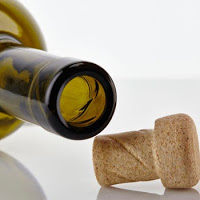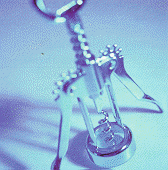![]() Ah, the noble wine cork. Protector of the precious nectar, yet frequently blamed for flavor changes completely unrelated. But a cork is a cork is a cork, right? Well, yes, unless we’re talking screw-tops or those nasty plastic thingamajigs. After thousands of years, a new and exciting advancement in the world of corkage is revealed: the helix cork. What choice do we have? We must raise our glasses to this new and wonderful evolution of the might cork.
Ah, the noble wine cork. Protector of the precious nectar, yet frequently blamed for flavor changes completely unrelated. But a cork is a cork is a cork, right? Well, yes, unless we’re talking screw-tops or those nasty plastic thingamajigs. After thousands of years, a new and exciting advancement in the world of corkage is revealed: the helix cork. What choice do we have? We must raise our glasses to this new and wonderful evolution of the might cork.
 Picture, if you will, a champagne cork. Now mentally add a couple of spiral grooves running down the barrel of the cork. Imagine a wine bottle with ridges that miraculously mimic these spiral grooves. OK, you don’t actually need to imagine anything, just look at the promotional photograph that’s right here. Pretty slick, though, isn’t it?
Picture, if you will, a champagne cork. Now mentally add a couple of spiral grooves running down the barrel of the cork. Imagine a wine bottle with ridges that miraculously mimic these spiral grooves. OK, you don’t actually need to imagine anything, just look at the promotional photograph that’s right here. Pretty slick, though, isn’t it?
Cork is a wonderful bottle stopper. It is made from the bark of the cork tree, so it is a renewable resource, keeping the cost low and our consciences clear. The only apparent problem with corks is that pesky corkscrew gadget that is required to remove the cork from the bottle. Well, that and the slight hassle in trying to get a good seal when re-inserting the cork on those rare occasions when the wine outlasts the party.
 The new Helix cork is made from tiny granules of cork, so the messy bits that are left over after nice round (traditional) cork barrels are created can live a productive cork life as a helix cork now. The groove and ridge system improves the seal while making the cork easier to remove without a corkscrew. Everybody wins!
The new Helix cork is made from tiny granules of cork, so the messy bits that are left over after nice round (traditional) cork barrels are created can live a productive cork life as a helix cork now. The groove and ridge system improves the seal while making the cork easier to remove without a corkscrew. Everybody wins!
So keep your eyes peeled for these splendid new corks. The manufacturer expects to roll them out in the mid-priced wine market space first, so K&L Wines or similar stores should have them any day now.
Cheers to you, cork ol’ pal. We all appreciate your service.
About the Author: John grills a mean steak and is always in the market for another wine fridge. Believes that if a winery has more than 10 employees, it's probably too big. Buys wine faster than he drinks it, but who cares?

